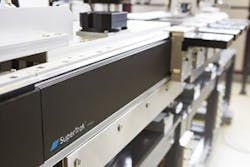New technology is popping up all over. Be sure you know what’s what before you begin implementing linear motion. The technology can bring accuracy and precision to many applications, but selecting components requires a bit of forethought. Our panel of industry experts discusses some new innovations.
What are some of the new technology innovations in linear motion today?
Brian Zlotorzycki is Etel motors product specialist at Heidenhain.
Figure 1: SuperTrak’s initial design was released in 2002, but the industry has not seriously considered this as an enabling technology until recently.
There’s linear transport technology or long stator linear motors (LLMs). B&R has worked very closely with ATS Automation to form a partnership on the SuperTrak, the third generation of ATS’s LLM technology. SuperTrak’s initial design was released in 2002, but the industry has not seriously considered this as an enabling technology until recently (Figure 1). We can see this by the increase in competitive technology within this space and the increase in marketing surrounding them. SuperTrak is a fully mature technology in an emerging product market with a lot of lessons learned over the years that have led to optimizations and various technical improvements.
Looped LLMs, such as SuperTrak, take advantage of the dynamic movements of linear motors and the tight control of servos to have a highly flexible and high-performance motion system.
This system gives users efficient and cost-effective batch-size-one production capabilities. It is a highly configurable system that allows each product that the SuperTrak carries to have a different recipe.
Derrick Stacey is solutions engineer at B&R Industrial Automation.
Josh Teslow is applications engineer at Curtiss-Wright.
Clint Hayes is product sales manager, linear motion technology at Bosch Rexroth.
Broc Grell is applications engineer at Nexen Group.
Aaron Dietrich is director of marketing at Tolomatic.
[pullquote]
Matt Prellwitz is motion product specialist at Beckhoff Automation.
Jay Johnson is national product manager at Sick.
ALSO READ: Putting Linear in Motion
Mike Bacidore is the editor in chief for Control Design magazine. He is an award-winning columnist, earning a Gold Regional Award and a Silver National Award from the American Society of Business Publication Editors. Email him at [email protected].
About the Author
Mike Bacidore
Editor in Chief
Mike Bacidore is chief editor of Control Design and has been an integral part of the Endeavor Business Media editorial team since 2007. Previously, he was editorial director at Hughes Communications and a portfolio manager of the human resources and labor law areas at Wolters Kluwer. Bacidore holds a BA from the University of Illinois and an MBA from Lake Forest Graduate School of Management. He is an award-winning columnist, earning multiple regional and national awards from the American Society of Business Publication Editors. He may be reached at [email protected]

Leaders relevant to this article:











